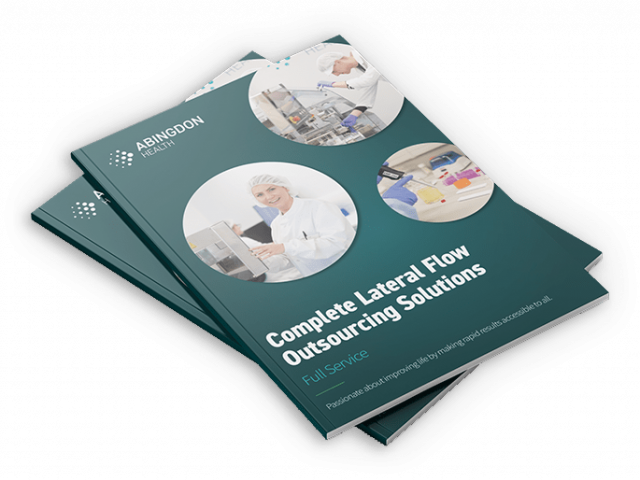Key Commercial Considerations When Developing a Self-Test Lateral Flow Assay

An Introduction To LFAs
Common Oversights
Key Technical Considerations
Getting Go-To-Market Ready
Key Takeaways
Abingdon Health’s Head of Sales and Marketing, Liam Currivan, looks at some of the important commercial considerations to be made right from the start of developing a Lateral Flow Assay (LFA) for the self-test market.
Liam draws on a wealth of experience commercialising products in the medical space, and has been instrumental in launching Abingdon Health’s Abingdon Simply Test range of self-test lateral flow tests as well as launching the first ever saliva pregnancy test, Salistick™, into the UK market with Superdrug, Tesco, and Amazon. Based on this experience, Liam provides some key insights into factors to consider when developing a lateral flow test to be sold to the general public.
An Introduction To LFAs
 Lateral Flow Assays (LFAs) are rapid diagnostic tests that can be used to detect the presence of a specific target molecule – such as an antigen or antibody – simply by untrained people, or professionals, within a matter of minutes. LFAs have always been an important rapid diagnostic tool whether that be in agriculture, food safety, environmental, and of course human health and wellbeing settings. In fact, self-testing LFAs have been in use since the early 1970’s in the form of pregnancy tests; and since Covid-19 brought LFAs to the homes of almost everyone, we at Abingdon Health have seen a significant increase in the number of LFAs being developed for the self-testing market. This empowers people to proactively manage their own health.
Lateral Flow Assays (LFAs) are rapid diagnostic tests that can be used to detect the presence of a specific target molecule – such as an antigen or antibody – simply by untrained people, or professionals, within a matter of minutes. LFAs have always been an important rapid diagnostic tool whether that be in agriculture, food safety, environmental, and of course human health and wellbeing settings. In fact, self-testing LFAs have been in use since the early 1970’s in the form of pregnancy tests; and since Covid-19 brought LFAs to the homes of almost everyone, we at Abingdon Health have seen a significant increase in the number of LFAs being developed for the self-testing market. This empowers people to proactively manage their own health.
Common Oversights
However, when you begin developing an LFA for diagnostic purposes, there are some important areas not to overlook at the outset. We often see the Regulatory Approach and Critical Pathway as one such area; but equally as important is how your target audience will receive and use the product. Having a working LFA is one challenge, getting your target audience to buy-in at the end is another.
Key Technical Considerations
When developing a self-test LFA, it is important to consider the needs of both consumers and commercial partners. Without this foresight, you may end up with a terrific product that stays on the shelf… Things to think about include:
- Problem driven solution: The first consideration is, what problem are you trying to solve? This should remain front and centre to guide the development process throughout and should include who your target customer is.
- Test performance: The LFA must be accurate enough to provide reliable results. 3 key elements of this are sensitivity (how well the test can identify the target molecule for true positives); specificity (how well the test doesn’t identify other molecules for true negatives); and limit of detection (the lowest concentration of the molecule that will provide a positive result). Your lateral flow CRO/CDMO partner will support you in ensuring your LFA is optimised to meet test performance requirements, which may also be influenced by regulatory guidelines, professional health guidelines (World Health Organisation, for example) and competing product performance.
- Ease of use: The LFA must be easy to use for consumers. The fewer steps the better. This also includes having clear instructions, being simple to set up, and easy to interpret. We are seeing increasingly novel ways of sample collection and running tests that improve the useability of products and allow for a better customer experience.
- Aesthetics: As well as ease of use, how the product looks is important for marketing and market up-take; from selecting the appropriate components (pipette, lancet, housing) to the right packaging, Instructions For Use (IFU), artwork design and instructional videos. Remember: the packaging is the first part of the product someone will see and feel.
- Speed: The LFA must provide results in a timely manner.
- What next? What should the consumer do in the event of a positive result? Are you providing support or helplines? This is an increasingly important aspect of providing a solution to the consumer.
Getting Go-To-Market Ready
In addition to the technical factors, it is also important to consider the marketing and commercialisation of the LFA. This includes developing a clear value proposition, identifying the target market, and developing a distribution strategy. Building a go-to-market plan is a valuable tool to guide you when nearing commercialisation, and the following aspects are critical to success:
- Messaging: How will the benefits of the LFA be communicated to the target market?
- Pricing: What is the right price for the LFA? It is important to consider the cost of the test, as well as the perceived value of the test to the target market. If you are targeting retail distribution, understanding their margin requirements and in-store / online marketing expectations early in the development is critical. Having a healthy marketing budget and ensuring enough margin is available for each potential link in the chain is also essential to broad adoption.
- Distribution: How will the LFA be distributed? Will it be sold directly to consumers, or will it be distributed through healthcare providers, retailers, resellers, distributors? And what does your network look like for each option?
- Marketing Channels: What online and offline marketing channels will be used to reach the target market? Some examples could be retailer online / offline options, social media (META, TikTok, LinkedIn), influencers with relevant audiences, paid advertising spend, and public relations. All of these come with varying levels of cost, so knowing your channels, the Customer Acquisition Costs (CAC) and Customer Lifetime Value (CLV) associated with online / offline marketing is vital.
- Design: This is particularly important if you have a consumer focused LFA where you expect someone to pick it up off a shelf or from a crowded online channel.
By carefully considering these points, and many others, developers can increase the chances of success for their LFA at the all-important phase of commercialisation.

Key Takeaway
Plan with the end goal in mind. At Abingdon Health, we have a track record of taking customers’ projects from idea to commercial success. We have a deep understanding of the self-test lateral flow rapid diagnostics market and are in regular dialogue with major retailers both in the UK and Europe. For more information on how Abingdon Health can support your lateral flow self-test product’s successful journey from idea to market, please contact a member of our team to discuss this subject in confidence.

